
Transport in Spain is characterised by a network of roads, railways, trams, air routes, and ports. Its geographic location makes it an important link between Europe, Africa, and the Americas. Major forms of transit generally radiate from the capital, Madrid, located in the centre of the country, to link with the capitals of the autonomous communities.

Renfe, officially Renfe-Operadora, is Spain's national state-owned railway company.
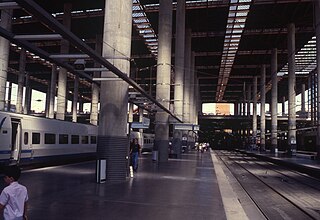
Red Nacional de los Ferrocarriles Españoles (RENFE) was a Spanish state-owned company that operated the national Iberian-gauge railway network between 1941 and 2005. For more than six decades and as a monopoly, it was exclusively responsible for the transport of passengers and goods on its lines, as well as for the management of its infrastructure.

Rail transport in Spain operates on four rail gauges and services are operated by a variety of private and public operators. Total railway length in 2020 was 15,489 km. The Spanish high-speed rail network is the longest HSR network in Europe with 3,966 km and the second longest in the world, after China's.

Alta Velocidad Española (AVE) is a high-speed rail service operated by Renfe, the Spanish State railway company.

The Perpignan–Barcelona high-speed line is an international high-speed rail line between Perpignan in Roussillon, France and Barcelona, Spain. The line consists of a 175.5-kilometre (109.1 mi) railway, of which 24.6 km (15.3 mi) are in France and 150.8 km (93.7 mi) are in Spain. The line is sometimes referenced as an extension of the Madrid–Barcelona high-speed rail line. The Perpignan–Barcelona line is a part of the Mediterranean Corridor.

High-speed railways in Spain have been in operation since 1992 when the first line was opened connecting the cities of Madrid, Córdoba and Seville. Unlike the rest of the Iberian broad gauge network, the Spanish High-speed network mainly uses standard gauge. This permits direct connections to outside Spain through the link to the French network at the Perthus Tunnel. High-speed trains run on a network of high-speed rail track owned and managed by ADIF, where the dominant service is AVE while other high speed services such as Avant, Alvia, Avlo, Euromed, Ouigo España and Iryo, as well as mid-speed (Altaria) services also operate.

Sagrera railway station is a major through station under construction in the Barcelona districts of Sant Andreu and Sant Martí, in Catalonia, Spain. It is intended to serve as the central station for northern and eastern Barcelona, with Sants serving as the central station for southern and western Barcelona. It will add a high-speed hub to the current two stations on the Madrid–Barcelona high-speed rail line, El Prat de Llobregat and Sants. The new station will be on the Perpignan–Barcelona high-speed rail line and additionally on the conventional Barcelona–Cerbère and Barcelona–Mataró–Maçanet-Massanes railways. Once fully completed, it will be a major public transport hub, with dedicated stations on Barcelona Metro lines 4 and 9/10, as well as a bus station. The complex will be fully underground excepting for the station building, with two levels of platforms, accounting for a total of 18 railway tracks.

Barcelona Sants is the main railway station in Barcelona, owned by Adif, the railway infrastructure agency of Spain. It has become the most important transport hub of the city - being the centre of Rodalies de Catalunya including Barcelona suburban railway services and regional services, as well as the main inter-city station for national and international destinations. The station is named after Sants, the neighbourhood of Barcelona in which it is located. New parts of the station have recently been remodeled to accommodate the Spanish high-speed train AVE in the city, which started serving the city on 20 February 2008. There is also an adjacent international bus station bearing the same name, and a link to the Sants Estació metro station that serves the railway station.

The Madrid–Barcelona high-speed rail line is a 621-kilometre (385.9 mi) standard gauge railway line inaugurated on 20 February 2008. Designed for speeds of 350 km/h (217.5 mph) and compatibility with neighbouring countries' rail systems, it connects the cities of Madrid and Barcelona in 2 hours 30 minutes. In Barcelona the line is connected with the Perpignan–Barcelona high-speed rail line leading into France which connects it to the European high speed network.
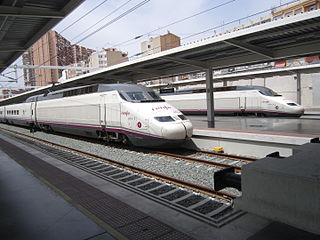
Alicante Terminal is the central railway station of Alicante, Spain. Commonly referred locally as the RENFE station, the station is part of Adif system, and is a terminal station.
The R10 was a line of Rodalies de Catalunya's Barcelona commuter rail service, operated by Renfe Operadora. It linked half-hourly Barcelona–El Prat Airport with Barcelona's Estació de França, using the Aragó Tunnel through central Barcelona, calling at Sants and Passeig de Gràcia stations. R10 services spanned 22 kilometres (14 mi) of railway lines and six stations. At the time it suspended services, the trains used on the line were Civia electrical multiple units (EMU).

Lleida Pirineus is an important railway station serving the city of Lleida in Catalonia, Spain. It is located between the neighbourhoods of Pardinyes and Rambla de Ferran. The first train services in Lleida date of 1860, but the station wasn't built until 1927, and it did not adopt its current official name until 2003, when it underwent an ambitious reform. As a transport hub connecting the interior of Spain with the Corredor Mediterráneo, it serves both broad gauge and standard gauge trains, operated by both Adif-Renfe and Ferrocarrils de la Generalitat de Catalunya. It is the terminus of several regional railway services centered in Aragon and Catalonia. It's also one of the stations on the Madrid–Barcelona high-speed rail line, and it was its north-eastern terminus until 2008.
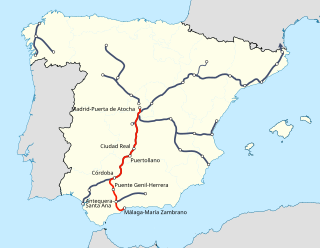
The Madrid–Málaga high-speed rail line is a standard gauge High-speed rail line of 512 km (318 mi) in length that links the city of Madrid with the city of Málaga in Spain. The line was inaugurated on 24 December 2007. At the time the service opened, Renfe Operadora was running 22 trains daily between Madrid and Málaga.

ADIF is a Spanish state-owned railway infrastructure manager. This state owned company reports to the Ministry of Transport and Sustainable Mobility. ADIF is charged with the management of most of Spain's railway infrastructure, that is the track, signaling and stations. It was formed in 2005 in response to European Union requirements to separate the natural monopoly of infrastructure management from the competitive operations of running train services. It is the legal successor of Renfe, Feve, and GIF.
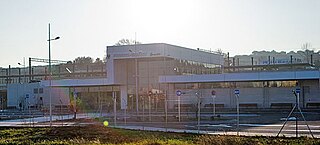
Figueres–Vilafant is a railway station serving the city of Figueres in Catalonia, Spain. It is located in the municipality of Vilafant, at about 2 kilometres (1.2 mi) west from its urban center and 1.5 kilometres (0.93 mi) from Figueres city centre. The station is on the Perpignan–Barcelona high-speed rail line and is served by Renfe Operadora's AVE and SNCF's TGV high-speed trains.
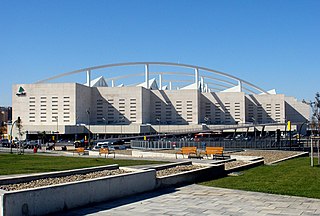
Zaragoza–Delicias station is a railway station located in the city of Zaragoza in Aragon, Spain. The station opened on 7 May 2003, and the Central Bus Station Zaragoza opened on 5 May 2007, providing a wide intermodality to passengers. It is served by the AVE high-speed trains between Madrid and Barcelona and onwards to Figueres.

León railway station is the railway station of the Spanish city of León.

Valencia-Joaquín Sorolla railway station is a railway station in Valencia, Spain, opened in 2010. Along with Estació del Nord, it is a city centre terminus station, primarily serving AVE high-speed rail services, with Estació del Nord serving all other passenger rail traffic.

Iryo is the brand of Intermodalidad de Levante S.A. (ILSA), a private high-speed rail operator in Spain. The company is jointly owned by the Italian state-owned railway company Trenitalia (45%), the Spanish regional airline Air Nostrum (31%), and the Spanish infrastructure investment fund Globalvia (24%).




















